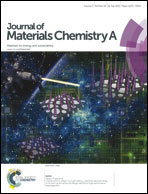Study on hole-transport-material-free planar TiO2/CH3NH3PbI3 heterojunction solar cells: the simplest configuration of a working perovskite solar cell†
Abstract
Perovskite solar cells have been widely investigated owing to their high efficiency and low production cost. The working principle of perovskite solar cells is also a hot research topic. Investigations show that either the microporous oxide layer or the hole transport material could be omitted (planar configuration vs. hole-transport-material-free configuration). However, it is not known if the configuration of perovskite solar cells could be further simplified. In this work, we report on a simple hole-transport-material-free planar heterojunction perovskite solar cell with the structure FTO/hole blocking layer (compact TiO2 film)/CH3NH3PbI3/Au. We achieved a power conversion efficiency of 10.04% under one sun illumination for this simple configuration of perovskite solar cells using high-quality planar CH3NH3PbI3 films grown by a well reproducible method. Capacitance–voltage measurements show that a built-in field aiding in taking out the photocurrent to the external circuit and suppressing the back reaction of electrons from the TiO2 to the CH3NH3PbI3 film was formed in the TiO2/CH3NH3PbI3 interface depletion region. Impedance spectroscopy measurements show that a transport resistance Rtr originating from the perovskite active layer was suppressed by a large number of photo-generated currents produced at the CH3NH3PbI3 layer under light illumination.



 Please wait while we load your content...
Please wait while we load your content...